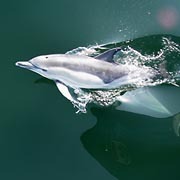
|
| ©DPA |
| A dolphin swims along side a police boat in the Baltic Sea, Sunday. It was the first such sighting in the area for many years. |
Germany's martime experts are excited at the appearance of some friendly visitors to the country's northern shores. Two dolphins have been spotted in the Baltic Sea -- the first sighting of these creatures here for many years. Scientists are assuming that their sudden appearance is linked to global warming.
The crew on a police boat captured the two dolphins on camera as they patrolled the sea between the Darss Peninsula and the island of Hiddensee on Sunday.
The sighting of the dolphins has caused quite a sensation amongst German maritime experts. The mammals are normally found in warmer waters, for example in the Mediterranean and along the coast of Africa. So their appearance near the shores of slightly chillier northern Germany is thought to have something to do with the rising temperature of the oceans. The last time dolphins were spotted in the Baltic Sea was back in 2001.
The animals viewed on Sunday were a female dolphin and her calf. The ocean mammals accompanied the boat for around four hours, frequently making leaps and dives in and out of the water. The mother also suckled the young dolphin -- something quite unusual to see, according to Harald Benke, director of the German Oceanographic Museum in Stralsund. "The animal must be very trusting to suckle its young in front of the crew," he told the DPA news agency.
As long as it doesn't get too cold, Benke thinks the dolphins stand a good chance of surviving in the waters of the Baltic. Dolphins feed on herrings and Benke predicts that any shortage of the fish, rather than cold temperatures, could force the dolphins to move on to other more attractive waters.



Reader Comments
to our Newsletter